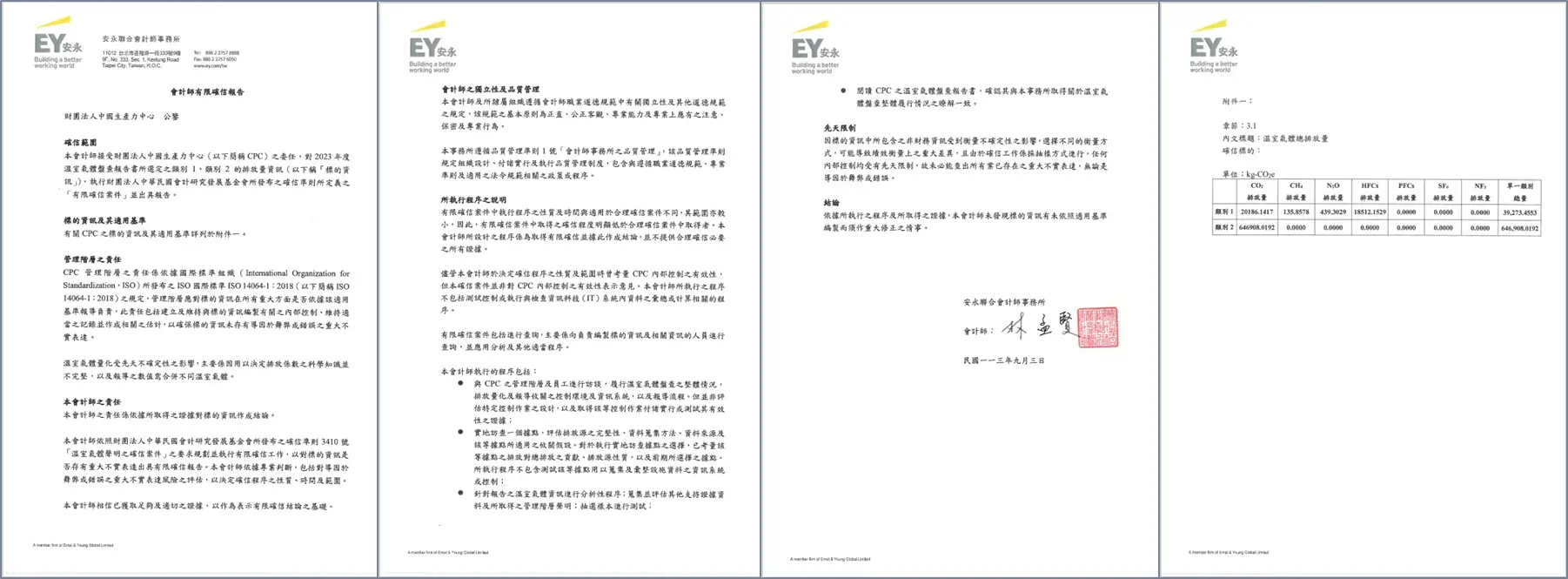In pursuit of its vision to reduce environmental impact, CPC shall actively respond to changes and enhance its organizational green productivity and international competitive advantage. The issuance of the report demonstrates CPC’s efforts to mitigate global warming and fulfill its responsibility as a member of the global community.
Material Topic action management goal - align with international trends to disclose GHG information
CPC started conducting greenhouse gas inventory in 2022 and completed assurance and verification in 2023.
For scopes 1 and 2, 2022 was set as the base year to enact the medium and long-term reduction goals for reaching the carbon reduction benchmark. With an annual reduction of 0.5%, a goal of 2% reduction in 2026 (approximately 14 t-CO2e), and a goal of 4% reduction in 2030 (approximately 28 t-CO2e) were set. CPC revised the goals set in 2022 in 2023 for more practical reduction goals.
Scope 3 mainly consists of GHG emissions from employees' commutes and business travels. The emission reduction plans were formulated mainly for scopes 1 and 2 due to CPC‘s nature of business and employees commuting to work is essential.
Furthermore, CPC is committed to corporate sustainable development and is focused on climate governance topics. With the synchronized adaption of TCFD greenhouse gas emission reduction goals are enacted based on the aforementioned expertise.
Greenhouse Gas Reduction Policy Statement (Base Year as 2022)
To align with the national greenhouse gas reduction strategy and achieve environmental sustainability goals, CPC has been vigorously implementing various measures, including comprehensive greenhouse gas inventory and reduction plans. Specific implementations are as follows:

GHG Inventory
CPC has been conducting an annual inventory of greenhouse gas emissions across all service locations and obtaining external assurance verification starting in 2022. The primary references for this inventory are the GHG Protocol and ISO/CNS 14064-1:2018 standards. Emission calculations adopt the “emission factor method,” with emission factors derived from the “Greenhouse Gas Emission Factor Management Table 6.0.4,” “Announcements from Product Carbon Footprint Information Platform,” latest power factors from the Energy Administration, product carbon footprints provided by vendors, and other standard published by the Environmental Protection Administration, Executive Yuan. The global warming potential (GWP) values adopted in the calculations are based on the IPCC's Sixth Assessment Report published in 2021.
Boundaries of Inventory
The scope includes all the areas of Xizhi, Chengde, Taoyuan, Taichung, South Yunlin, Tainan, STSP, and Kaohsiung with a total of 8 service locations, the period is from the 1st of January, 2023 to the 31st of December, 2023.
Inventory Results
The total greenhouse gas emissions for 2023 is 1,525.473 metric tons of CO2e.

CPC Greenhouse Gas Inventory Report/Assurance Report

Description of the comparison between the two years
The total greenhouse gas emissions amounted to 1525.473 metric tons CO2e in 2023, an increase of 62.10 metric tons CO2e compared to 1,463.370 metric tons CO2e in 2022.
The disclosure of CPC Inventory Information covers categories 1 to 4 with descriptions respectively.

Carbon Reduction Analysis
Category 1 and 2: Reduction of 11.2 tons of CO2e, with a decrease of 0.6%, the main reasons are:
Category 1: Increase of 2.75 tons of CO2e, primarily due to the use of fuels for practical training purposes. Since this is the compulsory condition for an increase in operation, we will take more proactive management measures in the future, such as reducing standby time, replacement of outdated equipment, and others for carbon reduction.
Category 2: Decrease of 13.95 tons of Co2e, this category is mainly as the greenhouse gas emission sources (proportioned as 42.41%), including indirect emissions from electricity usage, the total contribution can reach 50.76%. In recent years, proactive energy-saving measures have been implemented, such as turning off lights during lunch breaks, replacing equipment (in Chengde and Kaohsiung offices), and reducing idle time in unoccupied classrooms. Shows good carbon reduction performances and we will continue to advance carbon reduction.
Category 3+4: Increase 118.73 tons of CO2e in all of the regions, mainly due to:
Category 3: Reduction of 159.54 tons of CO2e, primarily due to adjustments in the categorization method for emission sources. The emission source "postage" was under Category 3 in 2022, but after a review, it was reclassified under Category 4 in 2023 to better reflect the actual situation. The adjustment amounts to approximately 244.2 tons of CO2e, resulting in an actual increase in Category 3 emissions. The primary reason for this increase is the rise in business travel. Business activities in 2023 are with significant growth compared to 2022, leading to a substantial increase in the frequency and intensity of employee travel by transportation.
Category 4: Increase of 232.84 tons of CO2e, of which 244.2 tons is due to the reclassification adjustment from Category 3. As a result, there is no significant increase in Category 4 itself. The difference is attributed to the increased consumption of gasoline and diesel in Category 1, leading to a rise in indirect emissions.
Overall, the total emissions in 2023 increased by approximately 62.10 tons. The primary reason for this increase is the growth in business activities, which has led to a proportional rise in data from various activities.
However, data of emissions for Scope 1 and 2 have shown a decline, demonstrating CPC's proactive efforts in energy transformation. This reflects a concrete commitment to and tangible performance in advancing ESG transformation.
